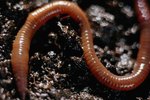
Rotifers are all around you, living in abundance in various plants, fresh water and soil. These microscopic organisms may be small, but they're considered animals rather than bacteria or protozoa. Members of the phylum Rotifera share several key characteristics that separate them from other microscopic creatures.
Size and Shape
There are thousands of rotifer species floating around inside plants and aquatic ecosystems throughout the world, so there's a lot of variation in their physical dimensions. Some resemble squares, circles and other geometric shapes, while others have oblong or asymmetrical bodies. Rotifers are between 0.004 and 0.02 inches long with an average of about a thousand cells each, according to the Lamar University Department of Biology. While they are clearly visible with the help of a microscope, scientists have had a hard time studying ancient rotifers because their small bodies make poor fossils.
Basic Anatomy
The rotifer body is divided into four sections: head, neck, body and foot. The head supports a series of mobile tentacles called cilia, which propel water into the organism's mouth, according to University of California Museum of Paleontology. The neck region contains a throat-like tube that funnels water into the rotifer's stomach and other organs, which are located in the body section. The foot protrudes from the organism's rear as an oar or spine to give the rotifer some control over its movement in liquid environments. Rotifers are bound by thin layers of clear skin, but many also have a harder shell called a lorica. Rotifers are invertebrates, so they have no spine or skeletal structure to maintain their shape.
Feeding
The rotifer's jaws, called trophi, are found inside the throat behind the mouth entrance. They break down edible material in the water as it funnels through the creature's body. Rotifers may be small, but they certainly aren't the smallest critter in most water ecosystems. They survive by eating small chunks of organic matter as well as plankton and other microscopic creatures. Of course, rotifers themselves are food for other animals, including shrimp and other shellfish.
Growth and Reproduction
One of the most interesting characteristics of rotifers is their cells' inability to reproduce. The cells of most animals divide at regular intervals to make up for dying cells. This process is essential for the long-term health of humans and most animals. Cells of rotifera grow larger as the organism ages, but they don't increase in number. Female rotifers are larger than males and are able to reproduce asexually without the help of a mate. However, a male and female can produce offspring through sexual reproduction during direct physical contact.
References
Photo Credits
-
Ablestock.com/AbleStock.com/Getty Images
Writer Bio
Quentin Coleman has written for various publications, including All Pet News and Safe to Work Australia. He spent more tan 10 years nursing kittens, treating sick animals and domesticating semi-feral cats for a local animal shelter. He graduated from the University of Delaware with a bachelor's degree in journalism.



